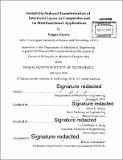| dc.contributor.advisor | Mary C. Boyce and Nicholas X. Fang. | en_US |
| dc.contributor.author | Kaynia, Narges | en_US |
| dc.contributor.other | Massachusetts Institute of Technology. Department of Mechanical Engineering. | en_US |
| dc.date.accessioned | 2016-07-01T18:45:24Z | |
| dc.date.available | 2016-07-01T18:45:24Z | |
| dc.date.copyright | 2016 | en_US |
| dc.date.issued | 2016 | en_US |
| dc.identifier.uri | http://hdl.handle.net/1721.1/103494 | |
| dc.description | Thesis: Ph. D., Massachusetts Institute of Technology, Department of Mechanical Engineering, 2016. | en_US |
| dc.description | Cataloged from PDF version of thesis. | en_US |
| dc.description | Includes bibliographical references (pages 237-241). | en_US |
| dc.description.abstract | Inspired by the undulating patterns found in different plant and biological cells in nature, this thesis explores the deformation-induced wrinkling instability transformation in the microstructure of composites with thin interfacial layers. The hybrid microstructure of a composite material has an essential influence on the effective properties and behavior of the composite. Hence, in this research, the principles and mechanics of interfacial layer instabilities are purposely designed to achieve sudden pattern transformations in the composite structure to generate new controlled multifunctional behavior. The wrinkling instability transformation is investigated in multilayered and networked composites consisting of relatively stiff interfacial layers or cells embedded in a soft matrix. Through analytical modeling, finite element simulations, and physical experiments, a comprehensive study is performed to elucidate: i) the conditions governing wrinkling, ii) the effect of wrinkling on local deformations, iii) the energy stored and dissipated in wrinkling composites, and iv) the change in the effective mechanical behavior of the composites. It is concluded that these properties are directly dependent on the composite's material and geometrical properties, and that composites can be designed to exhibit enhanced energy absorption (including energy storage and dissipation), stress mitigation effects, bilinear and multi-linear elastic stress-strain behavior, switchable effective stiffness, and can be used for energy harvesting applications. Design guidelines are presented to assist the process of deploying instability-transformation to tune, control, and switch the mechanical properties of multifunctional composite materials. Instability principles such as buckling and wrinkling are favorable mechanisms as they can be designed to be elastic and therefore reversible. The ability to alter and transform the microstructure enables on-demand tunability and active control of the composite's properties and attributes. | en_US |
| dc.description.statementofresponsibility | by Narges Kaynia. | en_US |
| dc.format.extent | 264 pages | en_US |
| dc.language.iso | eng | en_US |
| dc.publisher | Massachusetts Institute of Technology | en_US |
| dc.rights | M.I.T. theses are protected by copyright. They may be viewed from this source for any purpose, but reproduction or distribution in any format is prohibited without written permission. See provided URL for inquiries about permission. | en_US |
| dc.rights.uri | http://dspace.mit.edu/handle/1721.1/7582 | en_US |
| dc.subject | Mechanical Engineering. | en_US |
| dc.title | Instability-induced transformation of interfacial layers in composites and its multifunctional applications | en_US |
| dc.type | Thesis | en_US |
| dc.description.degree | Ph. D. | en_US |
| dc.contributor.department | Massachusetts Institute of Technology. Department of Mechanical Engineering | |
| dc.identifier.oclc | 952421303 | en_US |
